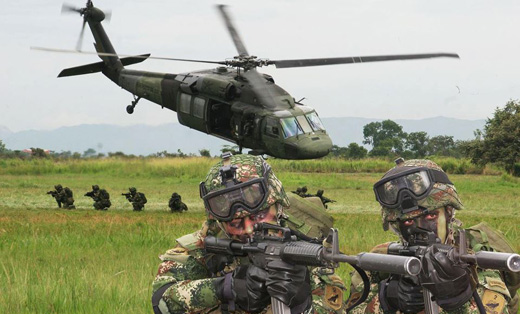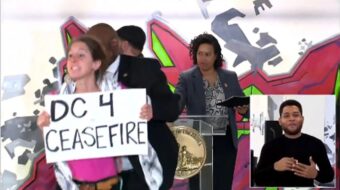
Peace negotiations between the Revolutionary Armed Forces of Colombia (FARC) and the Colombian government have continued for almost three years.
Partial agreements on agrarian reform, political participation, and illicit drugs have been reached, and an accord on “victims” is expected soon. Already “technical commissions” are dealing with final matters like relinquishing arms, verification, and removing land mines.
But will the talks yield real social justice? That’s what the FARC wants now just as it did when armed struggle began in 1964.
Obstacles loom. Agreements so far are partial ones. The whole package of agreements will require popular approval, and whether by referendum or a constituent assembly is unclear. There are other loose ends. The land problem, already dealt with in a partial agreement, is one, and uncertainty over political prisoners is another.
Land and its use have long preoccupied Colombia. “Colombian conflict in our era started in the 1920s and had its origin in the land, in the agrarian problem,” says land reform expert and journalist Alfredo Molano Bravo.
The Colombian government in August released the results of its first agricultural census in 45 years. According to official figures, as reported by TeleSur, 46 per cent of Colombia’s 250 million acres of rural lands are in the hands of 0.4 percent of landowners; their parcels average 1100 acres.
Seventy percent of landowners are left with only five percent of all rural land. Their individual tracts average less than 11 acres. Yet they produce 70 percent of Colombia’s food.
Some 48 million acres are potentially fit for growing crops, yet only 15.6 million acres (6.3 percent of the total rural land) are actually used for that purpose. The rest, 93.7 per cent, are given over to cattle-raising, mining, dams, oil extraction, and mono-crop agricultural production – or remain idle. Rural poverty is 44.7 percent.
Colombia imports 10 million tons of food annually. That only a tiny portion of land capable of growing crops is actually tilled demonstrates the prostration of small producers forced to compete with foreign agricultural interests advantaged through Colombia’s free trade agreements with industrialized nations.
Eberto Díaz is the president of FENSUAGRO, Colombia’s largest small farmer and agricultural workers union. He claims the census data is flawed and that the report serves to minimize problems of rural Colombia.
Citing a previous survey, he places rural poverty at 63 percent, 75 percent in some regions. Agricultural policy expert Jaime Muñoz regrets census data not being available to peace negotiators earlier, even though “a big part of those numbers … had little to do with realities of the rural world.”
Molano Bravo thinks that because the government was unable in the talks to certify the quantity of land available for redressing inequalities, it would have trouble “putting [land] at the disposition of small farmers once an agreement has been signed.”
Most importantly, however, the combined power of transnational corporations, big landowners, Colombia’s national bourgeoisie, and exploitative industrialized nations converts agitation or negotiation for equitable land use into a David and Goliath story. And worse: legions of paramilitaries, who enforce population displacements and battle dissidents, are on the side of that power.
Huber Ballesteros knows. In a recent background report, Ballesteros, a vice president of FENSUAGRO, indicates that, “Conflicts over land in the first three decades of the 20th century … incubated a terrible period of violence for the next half century. The contempt this oligarchy has always felt for the poor, and its colonial-feudal legacy, have always put the stamp of such politics on rural development.”
Violence over decades “in reality was a systematic plan for furthering agrarian counter-reform, [actually] for consolidating a model of rural development by means of state terrorism … It privileges property of the great landowners and expulsion of the small farmer class.”
Ballesteros also knows about force and intimidation. He writes from prison, having been jailed on August 25, 2013 at the culmination of a nationwide agrarian strike for which he was the spokesperson. Witnesses against him were paid by the government. There’s been no trial yet.
He joins 9,500 other political prisoners – unionists, academicians, student leaders, rural community leaders, and opposition activists. Former political prisoner Liliany Obando sees few signs of a reconciliatory plan for the prisoners as part of a future peace agreement.
In a recent article, she inveighs against a “politics that distorts the idea of political crime and converts the universal right of rebellion into a crime used as a weapon for persecuting those in the opposition; they face charges that are beyond the realm of political crime.” She worries about an agreement “reached while thousands of political prisoners are still behind bars, and especially those who were convicted unjustly.”
To question prospects for peace is to recall a familiar tension. From any rational point of view, tools used to fashion a just society ought to include political debate, peaceful agitation, legislative aplomb, democratic leadership, watchdog journalism, and an independent judiciary. But in Colombia division by social class intervenes and methods are different. Violent enforcers – paramilitaries, jailers, and others – are at work solidifying class antagonism. It’s easy to believe cards are stacked in regard to the negotiations.
Photo: Colombian army fighting FARC forces. | Wikipedia (CC)












Comments